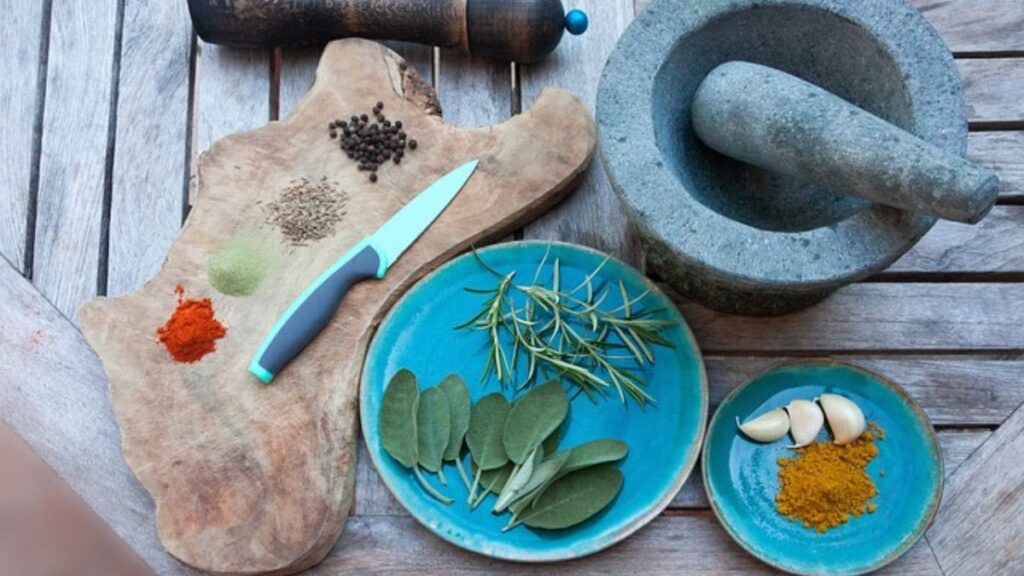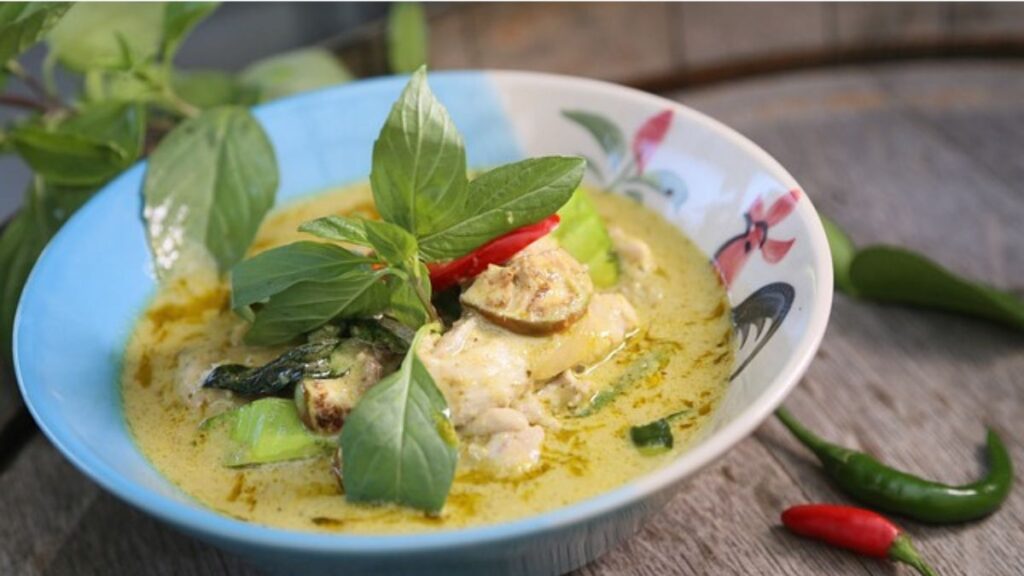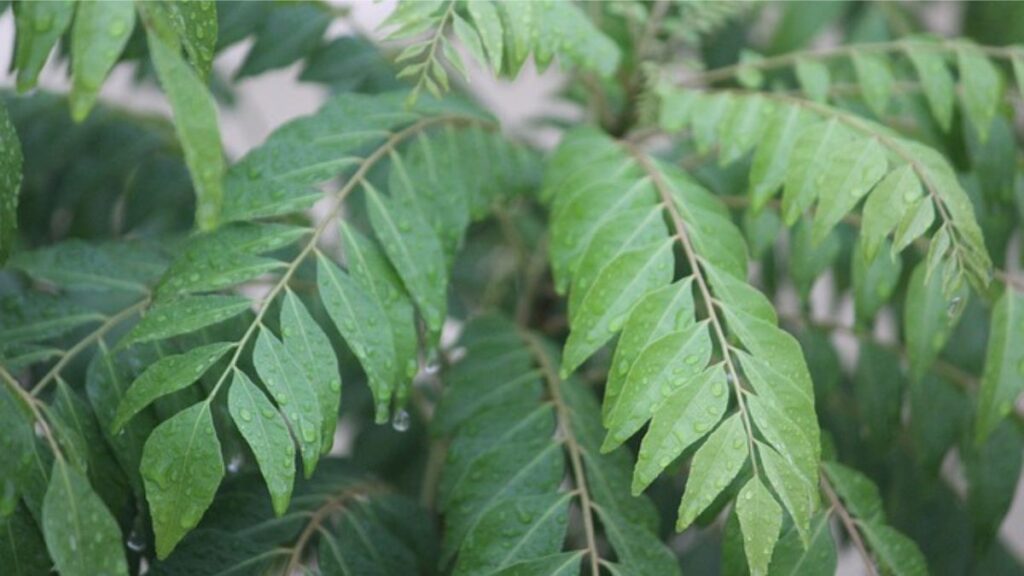Introduction:-
Beyond the Basics: Innovative Uses for Curry Leaves in Modern Cooking

Curry leaves, often overlooked, are cherished in South Asian cuisine for their distinct fragrance and nuanced flavor. In modern gastronomy, they’re finding innovative uses, elevating their culinary status.
The Basics: Understanding Curry Leaves
Curry leaves, native to the Indian subcontinent, hold a special place in cuisine. Originating from the curry tree (Murraya koenigii), these aromatic leaves carry a distinctive glossy appearance. Rich in nutrients such as vitamins A, B, C, and E, calcium, and antioxidants, curry leaves offer numerous health benefits. Traditionally employed in Indian cooking, these leaves enhance the flavor of curries, dals, and chutneys. By adding curry leaves to hot oil, their essential oils are released, intensifying the overall taste experience.
Modern Twists on Traditional Dishes
1.Curry Leaf Pesto:
- Blend fresh curry leaves with nuts, garlic, Parmesan cheese, lemon juice, and olive oil.
- Use it with pasta, sandwiches, or as a dip.
2.Curry Leaf Butter:
- Sauté curry leaves in butter until fragrant, then strain and chill.
- Use it to finish grilled meats, stir into steamed vegetables, or spread on bread.
3.Curry Leaf Salt:
- Grind dried curry leaves with sea salt and chili powder.
- Sprinkle it over roasted vegetables, use it to rim cocktail glasses, or add it to popcorn.
Fusion Flavors: East Meets West
- Curry Leaf Cocktails: Craft bartenders are always on the lookout for unique ingredients, and curry leaves are making their way into the mix. Try a curry leaf-infused gin and tonic or a mojito with muddled curry leaves for a fresh, aromatic twist. The herb pairs surprisingly well with citrus and floral notes.
- Curry Leaf Pizza: Give your pizza a flavor boost by adding curry leaves to the toppings. They pair wonderfully with Indian-inspired ingredients like paneer, tandoori chicken, and spicy tomato chutney. Bake until the leaves are crispy for a delightful texture contrast.
- Curry Leaf Desserts: Yes, you read that right! Curry leaves can add a surprising depth to sweet dishes. Infuse cream with curry leaves for a unique ice cream flavor, or incorporate them into a sugar syrup for drizzling over cakes and pastries. Their slightly citrusy, peppery notes work well with sweet, creamy bases.
Health Boosts: Beyond Flavor
Curry leaves offer anti-inflammatory and digestive benefits and can help control blood sugar. They enhance health, making them a valuable cooking ingredient.
Cooking Tips: Getting the Most Out of Curry Leaves
- Fresh vs. Dried Curry Leaves: Fresh curry leaves are preferred for their intense flavor, but dried leaves can be used as a substitute. Remember to use dried leaves sparingly as their flavor is more concentrated.
- Storage: To maintain their freshness, wrap fresh curry leaves in a damp paper towel and store them in an airtight container in the refrigerator. You can also freeze them for long-term storage.
- Preparation: In traditional and modern cooking, tempering curry leaves in hot oil is crucial. This step intensifies their flavor and enhances the overall dish.
What are some health benefits of curry leaves that make them a valuable addition to modern recipes?
Curry leaves are not only sought after for their distinctive taste and smell but also for their many health benefits, making them a worthy ingredient in contemporary recipes. Some of these benefits include:

- Antioxidant Powerhouse: Curry leaves are an excellent source of antioxidants, including flavonoids, phenolic compounds, and vitamin C, which help protect the body against oxidative stress and reduce the risk of chronic diseases like cancer and heart conditions.
- Digestive Support: The fiber in curry leaves promotes regular bowel movements and prevents constipation, aiding in digestion. Additionally, certain compounds found in these leaves have anti-inflammatory properties, helping to soothe the digestive tract.
3. Regulate Blood Sugar Levels: Studies suggest that curry leaves may help regulate blood sugar levels by improving insulin sensitivity and reducing insulin resistance. This makes them beneficial for individuals with diabetes or those at risk of developing the condition.
4. Protect Cardiovascular Health: The antioxidants and anti-inflammatory properties of curry leaves contribute to cardiovascular health by reducing oxidative stress, inflammation, and cholesterol levels. Regular consumption of curry leaves may help lower the risk of heart disease and stroke.
5. Boost Immune Function: The vitamin C content in curry leaves strengthens the immune system by promoting the production of white blood cells and enhancing the body’s defense against infections and diseases.
6. Promote Hair Health: Curry leaves are traditionally used in Ayurvedic medicine to promote hair growth and prevent hair loss. They are rich in nutrients like iron, calcium, and vitamins that nourish the scalp and strengthen hair follicles.
7. Support Weight Loss: The fiber content in curry leaves promotes feelings of fullness and satiety, which can help control appetite and prevent overeating. Additionally, the compounds in curry leaves may boost metabolism and aid in weight management.
8. Protect Against Neurodegenerative Diseases: Some research suggests that the antioxidants in curry leaves may help protect against neurodegenerative diseases like Alzheimer’s and Parkinson’s by reducing oxidative stress and inflammation in the brain.
9. Improve Eye Health: The vitamin A content in curry leaves is beneficial for maintaining healthy vision and preventing age-related eye disorders like macular degeneration and cataracts.
10. Anti-inflammatory Properties: Compounds found in curry leaves exhibit anti-inflammatory properties, which may help alleviate symptoms of inflammatory conditions such as arthritis, rheumatism, and gout.
Incorporating curry leaves into modern recipes not only adds flavor and aroma but also provides a myriad of health benefits that support overall well-being. Whether used in soups, salads, curries, or beverages, curry leaves offer a delicious and nutritious addition to any meal.
What are the best methods for preserving the flavor and aroma of curry leaves when storing them?
To keep curry leaves fresh and flavorful for cooking, proper storage is crucial. Here are some effective preservation methods:

- Refrigeration: For short-term storage (up to a few weeks), place fresh curry leaves in the refrigerator. Wrap them loosely in a slightly damp paper towel to maintain moisture. Then, store them in an airtight container or resealable plastic bag within the vegetable crisper drawer, which provides a slightly cooler and more stable temperature.
2.Freezing Curry Leaves for Long-Term Storage:
- Preparation:
- Thoroughly wash the curry leaves and gently pat them dry using a paper towel to remove excess moisture.
- Freezing Process:
- Arrange the curry leaves in a single layer on a baking sheet to prevent clumping during the freezing process.
- Place the baking sheet in the freezer and freeze the leaves until they are completely solid.
- Storage:
- Once frozen, transfer the curry leaves to a resealable freezer bag or an airtight container.
- Remove as much air as possible from the container before sealing it to minimize freezer burn.
- Usage:
- Frozen curry leaves can be stored for several months in the freezer.
- When needed, remove the desired quantity of leaves directly from the freezer and use them in your cooking without the need to thaw.
3.Vacuum Sealing
- Vacuum sealing is another effective method for preserving the freshness of curry leaves.
- Place the clean and dry leaves in a vacuum-sealed bag or container.
- Remove the air using a vacuum sealer.
- The airtight seal helps prevent oxidation and maintains the flavor and aroma of the leaves for an extended period.
4.Drying:
- Drying curry leaves is a popular method for preserving them, but it can reduce their flavor and aroma compared to fresh leaves.
- To dry curry leaves, spread them out in a single layer on a clean kitchen towel or drying rack.
- Place them in a well-ventilated area away from direct sunlight and moisture, such as a countertop or pantry.
- Allow the leaves to air dry for several days until they become crisp and brittle.
- Once dried, store them in an airtight container in a cool, dark place.
- Dried curry leaves can be crushed or crumbled before use to release their flavor.
5. Herb Keeper:
Herb keepers are specially designed containers that prolong the freshness of herbs, including curry leaves.
- These containers typically feature a water reservoir at the bottom to maintain humidity.
- They also have a perforated insert to allow air circulation.
- Place the curry leaves in the insert and store the container in the refrigerator for optimal preservation.
Follow these methods to preserve the flavor and aroma of curry leaves: refrigerate, freeze, vacuum seal, dry, or use a herb keeper. Proper storage is key to maximizing their shelf life.
Conclusion
Curry leaves, frequently overlooked, offer a unique flavor and health benefits. They add excitement to traditional Indian dishes and contemporary fusion cuisine. Experiment with curry leaves to elevate your culinary creations.
FAQs
Q1: What are curry leaves?
A1: Curry leaves come from the curry tree (Murraya koenigii), native to the Indian subcontinent. They are used for their aromatic, slightly citrusy, and peppery flavor in cooking and also offer various health benefits.
Q2: How do I store curry leaves?
A2: Store fresh curry leaves in the refrigerator wrapped in a damp paper towel inside an airtight container. For longer storage, you can freeze the leaves.
Q3: Can I use dried curry leaves instead of fresh ones?
A3: Yes, you can use dried curry leaves, but they have a more concentrated flavor. Use them sparingly and rehydrate them in water if needed.
References
- Culinary Uses of Curry Leaves
- Serious Eats
- https://www.seriouseats.com/how-to-use-curry-leaves
- Storage Tips for Fresh Herbs
- The Spruce Eats
- https://www.thespruceeats.com/how-to-store-fresh-herbs-4160061
- Fusion Recipes Incorporating Curry Leaves
- Bon Appétit
- https://www.bonappetit.com/recipes/slideshow/21-modern-indian-recipes








